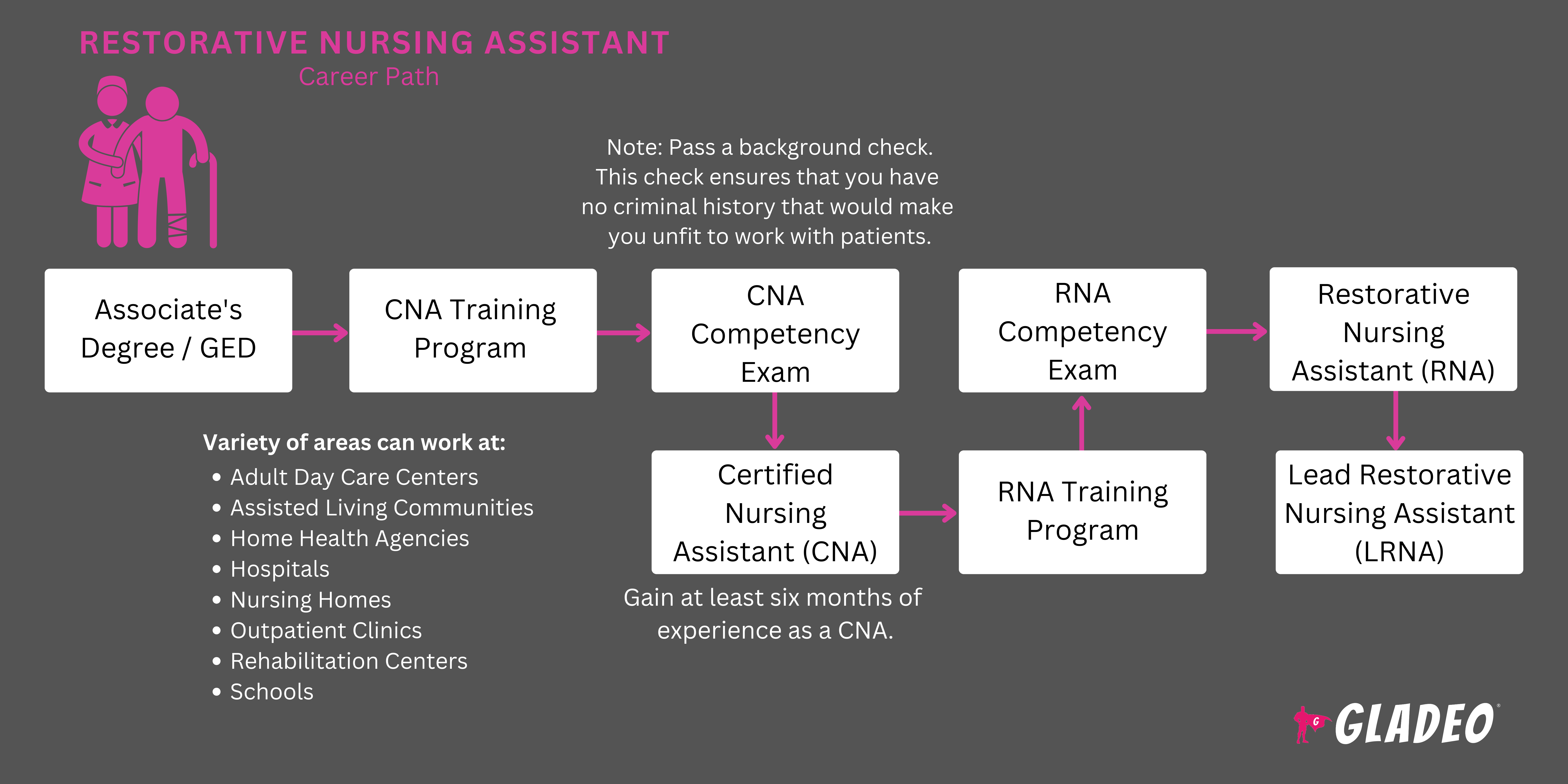Spotlights
Certified Medication Aide (CMA), Certified Nurse Aide (CNA), Certified Nurses Aide (CNA), Certified Nursing Assistant (CNA), Licensed Nursing Assistant (LNA), Nurses' Aide, Nursing Aide, Nursing Assistant, Patient Care Assistant (PCA), State Tested Nursing Assistant (STNA)
After a serious injury or long illness, patients often lose strength, coordination, and cognitive function and need help getting back to their normal lives. That’s where Restorative Nursing Assistants (RNAs) come into play!
RNAs specialize in restorative therapeutic care, assisting recovering patients to regain physical and cognitive capabilities through mobility exercises and activities. They work in a range of long-term settings, such as nursing homes and rehabilitation centers, performing tasks under the guidance of licensed nurses and therapists.
RNAs follow their patient’s rehabilitation plans, ensure patient safety and comfort, monitor and document progress, and communicate with the rest of the healthcare team so that plans can be adjusted, as needed. Their important work contributes greatly to the well-being of patients who are seeking to regain as much independence as possible.
- Making an impact on the health, life spans, and daily quality of life of patients
- Helping patients regain independence to perform daily tasks
- Growing demand in the healthcare field
- Numerous opportunities for personal and professional growth
Working Schedule
Restorative Nursing Assistants may work part-time or full-time. Shifts may include nights, weekends, or holidays.
Typical Duties
“An RNA is an advanced CNA [Certified Nursing Assistant],” writes Indeed. Thus there can be some overlap of duties between the two professions, depending on the setting and situation.
- Assist with therapeutic range-of-motion exercises, ambulation training, and other activities prescribed by physical or occupational therapists
- Support patients with personal hygiene (i.e., bathing, grooming, using the toilet) and dressing as they work toward independence and rehabilitation goals
- Serve meals and help patients eat, paying attention to the dietary needs of their care plan
- Help patients transfer between beds and wheelchairs. Assist with walking and repositioning for comfort and therapeutic benefit
- Monitor, record, and track patients’ progress in activities and exercises, noting changes in abilities or conditions
- Report any patient condition changes to the supervising nurse for appropriate action
- Provide companionship, support, and encouragement to patients working on restorative activities
- Document responses to restorative treatments, exercise progress, and health concerns
- Ensure effective communication between patients and healthcare professionals, including physical and occupational therapists, to ensure a cohesive approach to care
- Advocate for patient needs and preferences
- Suggest resources to learn more about nutrition and safety so patients can live healthier lives after being discharged
- If trained and authorized, RNAs may also:
- Assist with noninvasive medical procedures, such as dressing wounds
- Remind patients to take prescribed medications
- Assist with the collection of urine or stool samples
- Transport patients to appointments
Trách nhiệm bổ sung
- Assist with training new RNAs, sharing knowledge and techniques specific to restorative care
- Help set up and maintain equipment used for restorative exercises and activities
- Participate in interdisciplinary team meetings to discuss and plan patient care
- Assist with laundry, errands, and appointment scheduling
- Help with discharging patients
Kỹ năng mềm
- Cách cư xử bên giường bệnh
- Lòng thương
- Sự bình tĩnh
- Độ tin cậy
- Chú ý đến chi tiết
- Khả năng phục hồi cảm xúc
- Cảm
- Chính trực
- Kỹ năng giao tiếp
- Người quan sát
- Tính kiên nhẫn
- Sức bền thể chất
- Xây dựng mối quan hệ
- Độ tin cậy
- Ý thức an toàn
- Phán đoán đúng đắn
- Kỹ năng giao tiếp mạnh mẽ
- Làm việc nhóm và cộng tác
Kỹ năng kỹ thuật
- Knowledge of rehabilitation and restorative care techniques (i.e., exercises, mobility assistance, cognitive activities, etc.)
- Understanding how to encourage independence during rehabilitation
- Familiarity with hygiene, sterilization practices, and infection control in rehabilitation or long-term care settings
- Proficiency in using/maintaining equipment for restorative care
- Expertise in documenting and maintaining patient records
- Knowledge of common medical conditions in long-term care/rehabilitation settings
- Understanding the roles of rehabilitation professionals such as physical and occupational therapists
- Acute care hospitals
- Cơ sở điều trị bệnh Alzheimer
- Các trung tâm hỗ trợ sinh hoạt
- Community-based adult day care centers
- Cộng đồng hưu trí chăm sóc liên tục
- Các cơ quan y tế cộng đồng và chính phủ
- Cơ sở chăm sóc giảm nhẹ
- Đơn vị phục hồi chức năng bệnh viện
- Cơ sở chăm sóc điều dưỡng (cơ sở điều dưỡng có tay nghề)
- Viện dưỡng lão và cơ sở chăm sóc dài hạn
- Trung tâm ngoại trú
- Trung tâm phục hồi chức năng
- Specialized care facilities
- Therapy departments
Restorative Nursing Assistants play a crucial role in the rehabilitation and ongoing care of patients facing challenges due to age, disability, or chronic conditions. RNAs help implement and monitor tailored restorative care plans, sometimes for multiple patients each day. This requires excellent organizational and prioritization skills, along with diligent record-keeping.
Assisting patients with mobility and therapeutic exercises can be physically demanding. Meanwhile, daily interactions with recovering or ill patients can be stressful and emotionally taxing at times. Thus, resilience, patience, and empathy are always necessary.
RNAs frequently work night, weekend, and holiday shifts, requiring adaptability and a flexible schedule. They must also find time to decompress and manage appropriate self-care to maintain their own mental and physical well-being and avoid burnout.
The healthcare sector, especially in long-term and rehabilitative care, is facing a shortage of trained professionals—including RNAs. This is partially due to America’s aging population living longer and thus needing more years of specialized care.
The shortage is exacerbated by millions of nurses retiring or preparing to retire, creating a shortage of teaching staff to train their own replacements. As a result, RNA training program applicants should be persistent and keep applying to programs if they happen to get turned down at first.
Online educational programs are doing their part to make learning more flexible and reduce barriers to accessible training. In the meantime, the rising workload is stretching the current nursing workforce thin, raising the importance of self-care to prevent fatigue, stress, or burnout.
RNAs may have always been interested in physical activities and wanted to teach others about the long-term health benefits of exercise. In their younger years, they could have assisted loved ones who needed help due to age, injury, or illness. RNAs usually have a strong desire to make a difference in the lives of others, and the ability to motivate patients to stick with their care plans and overcome obstacles.
Giáo dục cần thiết
- To become an RNA, applicants generally need a high school diploma or equivalent, plus need to be a Certified Nursing Assistant (CNA)
- Some employers may hire applicants who are close to obtaining their CNA certification
- In addition to being a nursing assistant, RNA hopefuls must usually have relevant work experience (for example, six months of working as a CNA) and be in good standing with their respective state
- RNA training programs may require a letter of recommendation from the director of nursing where the CNA applicant last worked
- Qualified applicants can complete a state-approved RNA training program through a community college, vocational/technical school, nurse training school, or select four-year colleges. Some high schools offer CNA training courses to get a jump start on an RNA career
- Depending on the program, certain courses could be online, in-person, or via a hybrid method
- Note, the number of training hours may vary by state, institution, and other factors A typical program may include:
- 30 hours of classroom and laboratory instruction, with written tests
- 30 hours of supervised clinical practice, depending on the student's exhibited abilities
- A practical exam to evaluate skills related to speech therapy, occupational therapy, physical therapy, and other skills
- Courses cover “various essential topics related to restorative care, including rehabilitation and its function, effects of aging, basic anatomy, diseases impacting mobility, promoting independence, resident transfers, ambulation, types of exercise, available restorative aide equipment, communication, and medical terminology”
- Note, in some states, CNA certification involves passing an exam. In addition, some healthcare facilities have their own requirements
- RNA hopefuls must meet the same immunization requirements as a CNA (based on the demands of the state or employer), such as seasonal flu vaccination, Tdap, MMR, hepatitis B, varicella, and meningococcal
- They may have to pass criminal background and drug screening. Also, employers must find no registry information concerning abuse, neglect, or misappropriation of property
- RNAs may complete optional credentials, such as:
- American Board of Wound Management’s Certified Wound Care Associate
- American Council on Exercise’s Functional Training Specialty Certification
- American Medical Certification Association’s Patient Care Technician Certification
- American Phlebotomy Association’s Patient Care Technician
- American Red Cross Basic Life Support Certification
- Certified Medication Assistant (CMA)
- Hospice and Palliative Nurses Association’s Certified Hospice and Palliative Nursing Assistant
- National Association for Practical Nurse Education and Service’s Intravenous Therapy Certification
- National Center for Competency Testing’s Nationally Certified Patient Care Technician
- National Certification Board for Alzheimer Care’s Certified Alzheimer Caregiver
- National Council of State Boards of Nursing’s National Nurse Aide Assessment Program
- National Healthcareer Association’s Certified Patient Care Technician/Assistant
- Rehabilitation Engineering and Assistive Technology Society of North America’s Seating and Mobility Specialist
Restorative Nursing Assistants don’t have to attend training at a university. Training programs are available at community colleges, vocational/technical schools, nurse training schools, and select four-year colleges. In addition, CNA programs are offered in some high school programs.
- Review the exact CNA and RNA training and certification/licensure requirements for the state you plan to work for.
- Cân nhắc chi phí học phí (mức học phí trong tiểu bang/ngoài tiểu bang), chiết khấu, học bổng và các lựa chọn hình thức học (tại trường, trực tuyến hoặc chương trình kết hợp).
- Look for accredited programs with strong reputations and high pass rates for state certification exams, as applicable.
- Review the available options for hands-on training in local healthcare settings.
- Consider the duration of the program and the flexibility of class schedules, especially if balancing other commitments.
- Xem lại tiểu sử và giải thưởng của giảng viên. Tìm hiểu về tỷ lệ tốt nghiệp và số liệu thống kê việc làm. Khám phá những thành tựu của mạng lưới cựu sinh viên!
- Làm tình nguyện tại các cơ sở chăm sóc sức khỏe để có cơ hội tiếp xúc và học hỏi các kỹ năng thực tế
- Tham gia các lớp học ở trường trung học liên quan đến giải phẫu, sinh lý, sinh học, hóa học, giáo dục thể chất, dinh dưỡng, tâm lý học, khoa học sức khỏe, sơ cứu, toán và tiếng Anh
- Earn good grades so you can get accepted into a suitable RNA training program
- Develop a solid workout schedule so you build stamina and strength while managing stress
- Duy trì chế độ ăn uống lành mạnh và lịch ăn uống đều đặn để giữ mức năng lượng ổn định
- Tham gia các hoạt động của trường, nơi bạn có thể phát triển các kỹ năng quản lý dự án, làm việc nhóm, kinh nghiệm lãnh đạo và giải quyết xung đột
- Think about the format you want to take RNA classes in. Some topics are fine for online study, but others need to be learned in person
- Research any unique state or potential employer requirements for becoming an RNA. Keep in mind that you may have to pass a criminal background check or drug screening
- Request to do an informational interview with a working RNA to learn about their daily duties
- Check out online articles and videos about the Restorative Nursing Assistant career field, the various settings you could work in, and extra certifications you may want to pursue!
- Duy trì danh sách liên lạc (có số điện thoại hoặc email) có thể làm người tham khảo cho công việc trong tương lai
- Giữ một bản nháp sơ yếu lý lịch của bạn và cập nhật nó khi bạn có thêm kinh nghiệm

- Once certified as a CNA to work in their respective states, and after RNA training has been completed, it’s time to explore job postings via sites like Indeed, Glassdoor, healthcare-specific job search sites, and the websites of applicable employers
- Note, many recruiters have established pipelines with local CNA and RNA training programs, so talk to your school’s program manager or career center about job placement assistance
- Kết nối với các chuyên gia chăm sóc sức khỏe khác để tìm hiểu về các cơ hội việc làm. Đừng đánh giá thấp sức mạnh của việc tuyển dụng "truyền miệng" !
- Advertise yourself on LinkedIn and always keep your social media professional. Potential employers often screen candidates’ online activities
- Check out Restorative Nursing Assistant resumes for ideas on formatting, phrasing, and keywords to use
- Keywords may include: Restorative care, patient rehabilitation, mobility assistance, range of motion exercises, ADL support (Activities of Daily Living), patient monitoring, care plan implementation, therapy assistance, medical terminology, patient safety, compassionate care, teamwork, documentation, patient education, communication skills, adaptive equipment use, regulatory compliance, patient assessments, interdisciplinary collaboration, infection control
- Xem lại các câu hỏi phỏng vấn tiềm năng có thể gặp phải. Thực hiện một số cuộc phỏng vấn thử để luyện tập câu trả lời.
- Exhibit a hearty and nurturing attitude that conveys your ability to physically and mentally handle the workload
- Read about the strategies recruiters use, to gain a perspective of their mindset during interviews
- Ăn mặc chuyên nghiệp khi phỏng vấn
- Discuss your restorative care career goals with your supervisor. Ask for their guidance and mentorship
- Build a reputation for exceptional patient care and engagement related to restorative practices
- Familiarize yourself thoroughly with employer policies and procedures
- Closely follow restorative care plans and protocols to ensure patient safety and comfort as they recover
- Adhere strictly to sanitation and hygiene protocols
- Maintain effective communication with patients, nurses, and other healthcare team members
- Read journals and take continuing education courses to stay informed about the latest best practices
- Consider pursuing additional qualifications to expand your options and opportunities!
- Study guides and manuals for equipment and software. Become a go-to subject matter expert
- Demonstrate competence, integrity, reliability, initiative, professionalism, and leadership at all times
- Share insights and techniques with fellow RNAs, and set the example to follow
- Engage with professional organizations related to restorative and rehabilitative care
- Attend and participate in events. Be proactive in establishing and building your professional standing within your network!
Trang web
- Hiệp hội Điều dưỡng Chăm sóc Hậu cấp tính Hoa Kỳ
- Hiệp hội chăm sóc sức khỏe Hoa Kỳ
- Hiệp hội Y tá Hoa Kỳ
- American Occupational Therapy Association
- American Physical Therapy Association
- Commission on Collegiate Nursing Education
- Điều dưỡng lão khoa
- Gerontological Advanced Practice Nurses Association
- International Journal of Nursing Practice
- Tạp chí Chất lượng Chăm sóc Điều dưỡng
- Tạp chí Giáo dục Điều dưỡng
- Journal of Professional Nursing
- Journal of Rehabilitation Medicine
- Tạp chí của Hiệp hội Lão khoa Hoa Kỳ
- Hiệp hội quốc gia về chăm sóc tại nhà và chăm sóc giảm nhẹ
- Hiệp hội quốc gia về giáo dục và dịch vụ điều dưỡng thực hành
- National Association of Health Care Assistants
- Trung tâm Kiểm tra Năng lực Quốc gia
- Hội đồng Chứng nhận Quốc gia về Chăm sóc Bệnh Alzheimer
- Hội đồng Quốc gia về các Bác sĩ Chuyên khoa Chứng mất trí
- Hội đồng Quốc gia của Hội đồng Điều dưỡng Nhà nước
- Hiệp hội chăm sóc sức khỏe quốc gia
- National Rehabilitation Information Center
- Nurse.com
- Nursing Assistant Guides
- Nursing Assistants Online
- Tiêu chuẩn điều dưỡng
- Rehabilitation Nursing Journal
- Society of Certified Senior Advisors
- Tạp chí Điều dưỡng Hoa Kỳ
- The Gerontologist
Sách vở
- Mosby’s Essentials for Nursing Assistants, by Leighann Remmert MS RN, and Sheila A. Sorrentino Ph.D. RN
- Nursing Assistant: A Nursing Process Approach, by Barbara Acello and Barbara Hegner
- Restorative Care: Fundamentals for the Certified Nursing Assistant, by Barbara Acello
- Restorative Care Nursing for Older Adults: A Guide For All Care Settings, by Elizabeth Galik Ph.D. CRNP, Ingrid Pretzer-Aboff Ph.D. RN, et al.
RNAs are critical members of the healthcare profession, but the job can be physically demanding at times. For students who are interested in other healthcare-related career types, there are many additional options to consider, such as:
- Home Health or Personal Care Aide
- Licensed Practical Nurse (LPN)
- Medical Assistant
- Medical Records Specialist
- Y tá gây mê
- Y tá hộ sinh
- Nutritionist
- Nhà trị liệu nghề nghiệp
- Trợ lý trị liệu nghề nghiệp
- Optometrist Assistant
- Personal Fitness Trainer and Instructor
- Physical Therapy Assistant
- Physician Assistants
- Recreational Therapist
- Recreation Worker
- Registered Nurse (RN)
- Veterinarian Assistant
Nguồn cấp tin tức

Công việc nổi bật

Các khóa học và công cụ trực tuyến

Kỳ vọng về mức lương hàng năm
New workers start around $39K. Median pay is $41K per year. Highly experienced workers can earn around $48K. Median pay is ABOVE LIVING WAGE.
# Số lượng việc làm mở hàng năm

There are 99930 annual job openings due to growth and turnover in this career. Jobs in this field are projected to grow over the next 5 years.







